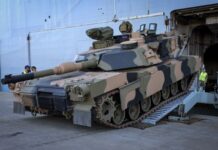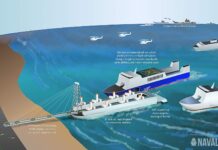
Arms for Russia and the Naval War in the Arctic 1941-1945. By Andrew Boyd. Seaforth Publishing, Barnsley, 2024. ISBN 978 1 3990 3886 7 (hardback) ISBN 978 1 3990 3887 4 (epub)
Reviewed by David Hobbs
This is the third book by Andrew Boyd to be published by Seaforth and, like its predecessors The Royal Navy in Eastern Waters and British Naval Intelligence through the Twentieth Century it is outstanding. He served in the RN as a submariner before joining the UK Diplomatic Service and later took a DPhil at the University of Buckingham where he remains a senior research fellow. He is also a fellow of the Royal Historical Society.
The supply of arms and other aid to the Soviet Union by the Western powers was a vital yet complex and dynamic aspect of the Second World War and the protection of the convoys carrying them through the Arctic were the most difficult and dangerous commitment in the Royal Navy’s long history. Andrew Boyd’s extensive archival research has enabled him to analyse a wide range of sources to give a new and challenging perspective on the delivery of Western aid to the Soviet Union between 1941 and 1945.
The convoys that delivered supplies through the Arctic route were the most fiercely contested and encountered by far the most difficult climatic conditions. Aid transported through other routes in the Middle East, Pacific and from Alaska eventually delivered more material but took longer to reach the end users and this mattered.
The book’s 499 pages of text are complemented by 40 pages of source notes and 17 pages of bibliography. Unlike previous historians who have described the Arctic convoys within set geographical limitations, Boyd explains how fighting an Arctic convoy through to its destination against intense, three-dimensional threats required about twenty per cent of the RN’s fleet resources.
With few exceptions, the RN provided the warships needed to protect them but no warships were stationed permanently in the Arctic. They had to be assembled for each convoy and comprised the same ships that operated in the Atlantic, Mediterranean and Indian Ocean theatres; later on in the Pacific as well.
The cruiser Belfast, for instance, took part in the sinking of the Scharnhorst off North Cape and bombarded enemy shore positions in Normandy on D-Day. The battleship Duke of York took part in the Battle of North Cape and was present at the Japanese surrender in Tokyo Bay. Arctic convoys had at times to be suspended when the RN was simply unable to concentrate the warships needed to defend them adequately and this had to be accepted by the political leadership.
At the high strategic level, Churchill and Roosevelt had to balance the imperative need to provide aid to the Soviet war effort with their evolving plans to fight a global war against three Axis partners which relied on effective command of the sea to underpin every move. Boyd describes the inevitable interaction between high strategic policy, national interest, intelligence and tactics with clarity; many of the latter developed from the convoys that had been fought through the Mediterranean to relieve Malta. At first aid was seen as being necessary to keep the Soviet Union from collapsing.
After the 1941 German offensive was blunted, the Western leaders appreciated that aid was still required to sustain large Soviet forces in action on the Eastern front, wearing down German forces and preventing them from contemplating operations in the west. Later in the war the purpose of the aid further evolved into helping the Soviet economy to recover with the delivery of transport, technology such as communications and sonar equipment matching the continued delivery of tanks, aircraft and explosives.
The Chiefs of Staff in both the UK and USA saw the delivery of weapons as a reduction in the amount of material available to them to fight their own campaigns in the Far East and North Africa but both had to accept the strategic imperatives decided by Churchill and Roosevelt.
Andrew Boyd disputes the long-standing view that the provision of aid to the Soviet Union was essentially discretionary and carried out for political rather than military reasons. While he always demanded more, Stalin deliberately understated the value of the aid he received. After 1945 and throughout the Cold War the Soviet leadership claimed that Western aid had made little impact on Russia’s ability to defeat Germany, a view that still influences attitudes in Vladimir Putin’s Russia.
Boyd uses statistics from documents made available after the collapse of the Soviet Union to explain that the reality is very different. Western aid, which came largely from the UK and Canada in the first year, was a vital multiplier of Soviet military power throughout the war and in the critical early months might even have achieved its aim of making the critical difference between survival and the early defeat Hitler envisaged. Churchill and Roosevelt both realised that the need to provide aid was grounded in strategic necessity and the number and timing of convoys was a constant preoccupation.
Supplies included not only thousands of fighter and bomber aircraft, tanks and ammunition but significant quantities of strategic materials such as aluminium, tin, copper, rubber, grain and even sugar. Some weapons such as the Vickers Valentine tank proved so popular with the Red Army that it had to be retained in production for Soviet use well after being replaced in the British Army. Thousands saw action on the Eastern front.
The interplay between intelligence, operational control and tactics is a theme that runs through the text, especially in the chapter that covers Convoy PQ 17. I found the description of personalities and events in the Operational Intelligence Centre situated in the bunker under the Admiralty as the tragedy of PQ 17 unfolded to be particularly gripping. The constant threat posed by German heavy ships including Tirpitz and Scharnhorst is described in detail as is the complicated, risk-averse, German command structure that aften failed to make the best use of the assets available to it.
Boyd notes the striking difference between the RN Force K in the Mediterranean which clinically destroyed the Italian Beta convoy when it carried out an intelligence-led interception and the failure of German surface ships to obtain similar results in the Barents Sea. The Battles of the Barents Sea and North Cape, together with Operations SOURCE, the RN ‘X’-Craft attack and TUNGSTEN, the Fleet Air Arm attack on Tirpitz in Kaa Fjord are also described.
Overall, this book presents important new perspectives on the provision of aid to the Soviet Union by the Western powers from strategic, intelligence, command and tactical viewpoints as well as describing how the three-dimensional forces that opposed the supply convoys in the Arctic were defeated. It is an outstanding work of historical scholarship that deserves a place on the shelf of anyone with an interest in naval history or the development of modern naval methods of command and control using a variety of intelligence sources to maximum effect. I highly recommend it to fellow ANI members.



